Strategic System Thinking: Approaches to Strategic Management
VerifiedAdded on 2022/11/15
|15
|4335
|109
Essay
AI Summary
This essay critically appraises the statement "Systems thinking essentially seeks to understand phenomena as a whole formed by the interaction of parts" by Stacey (2011), in relation to the evolution of strategic thinking and its application within organizational management. The essay begins by defining strategic thinking and systems thinking, laying the foundation for exploring the interplay between these concepts. It then delves into different approaches to strategic thinking, emphasizing the importance of understanding the business environment. The discussion encompasses the complexity perspective, differentiating between simple and complex systems, and highlighting the significance of Complex Adaptive Systems (CAS) in modeling organizational complexity. The essay further examines the practical application of strategic thinking, focusing on analyzing the business environment using various strategic tools. The core argument emphasizes how systems thinking offers a holistic approach to understanding complex organizational challenges and making informed strategic decisions. The essay concludes by synthesizing the key themes, underscoring the value of systems thinking in navigating the dynamic landscape of contemporary business and fostering organizational success.
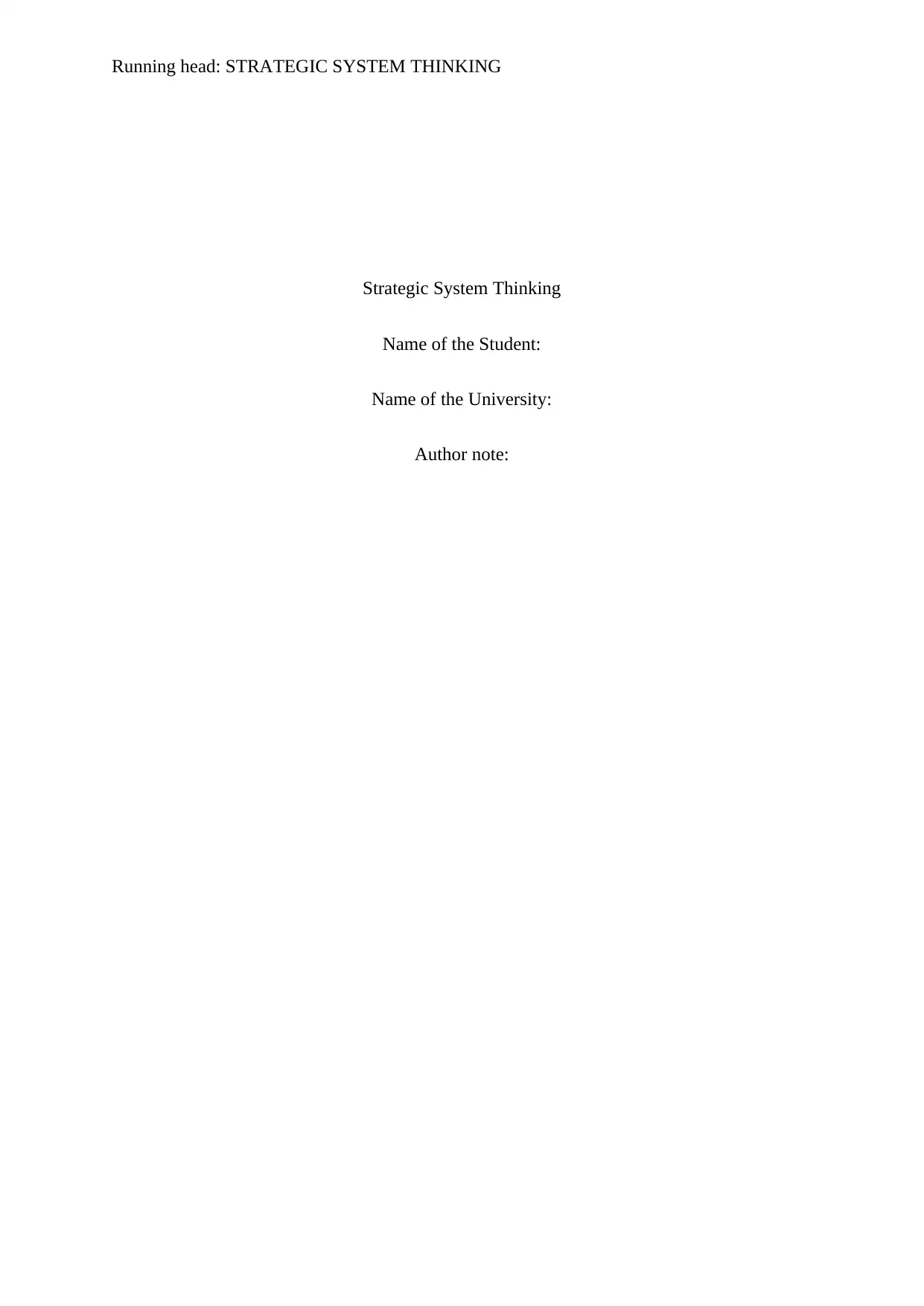
Running head: STRATEGIC SYSTEM THINKING
Strategic System Thinking
Name of the Student:
Name of the University:
Author note:
Strategic System Thinking
Name of the Student:
Name of the University:
Author note:
Paraphrase This Document
Need a fresh take? Get an instant paraphrase of this document with our AI Paraphraser
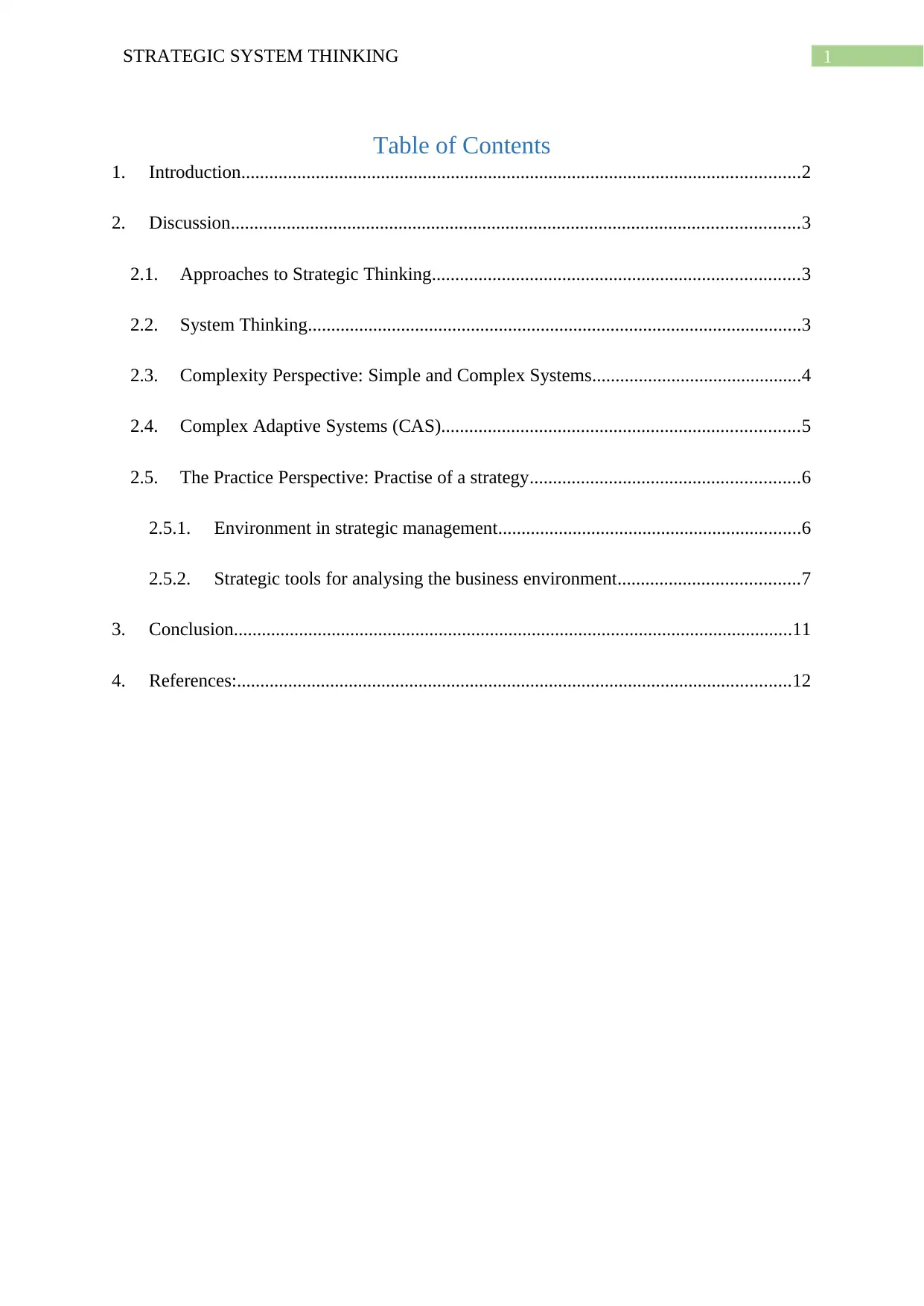
1STRATEGIC SYSTEM THINKING
Table of Contents
1. Introduction........................................................................................................................2
2. Discussion..........................................................................................................................3
2.1. Approaches to Strategic Thinking...............................................................................3
2.2. System Thinking..........................................................................................................3
2.3. Complexity Perspective: Simple and Complex Systems.............................................4
2.4. Complex Adaptive Systems (CAS).............................................................................5
2.5. The Practice Perspective: Practise of a strategy..........................................................6
2.5.1. Environment in strategic management.................................................................6
2.5.2. Strategic tools for analysing the business environment.......................................7
3. Conclusion........................................................................................................................11
4. References:.......................................................................................................................12
Table of Contents
1. Introduction........................................................................................................................2
2. Discussion..........................................................................................................................3
2.1. Approaches to Strategic Thinking...............................................................................3
2.2. System Thinking..........................................................................................................3
2.3. Complexity Perspective: Simple and Complex Systems.............................................4
2.4. Complex Adaptive Systems (CAS).............................................................................5
2.5. The Practice Perspective: Practise of a strategy..........................................................6
2.5.1. Environment in strategic management.................................................................6
2.5.2. Strategic tools for analysing the business environment.......................................7
3. Conclusion........................................................................................................................11
4. References:.......................................................................................................................12
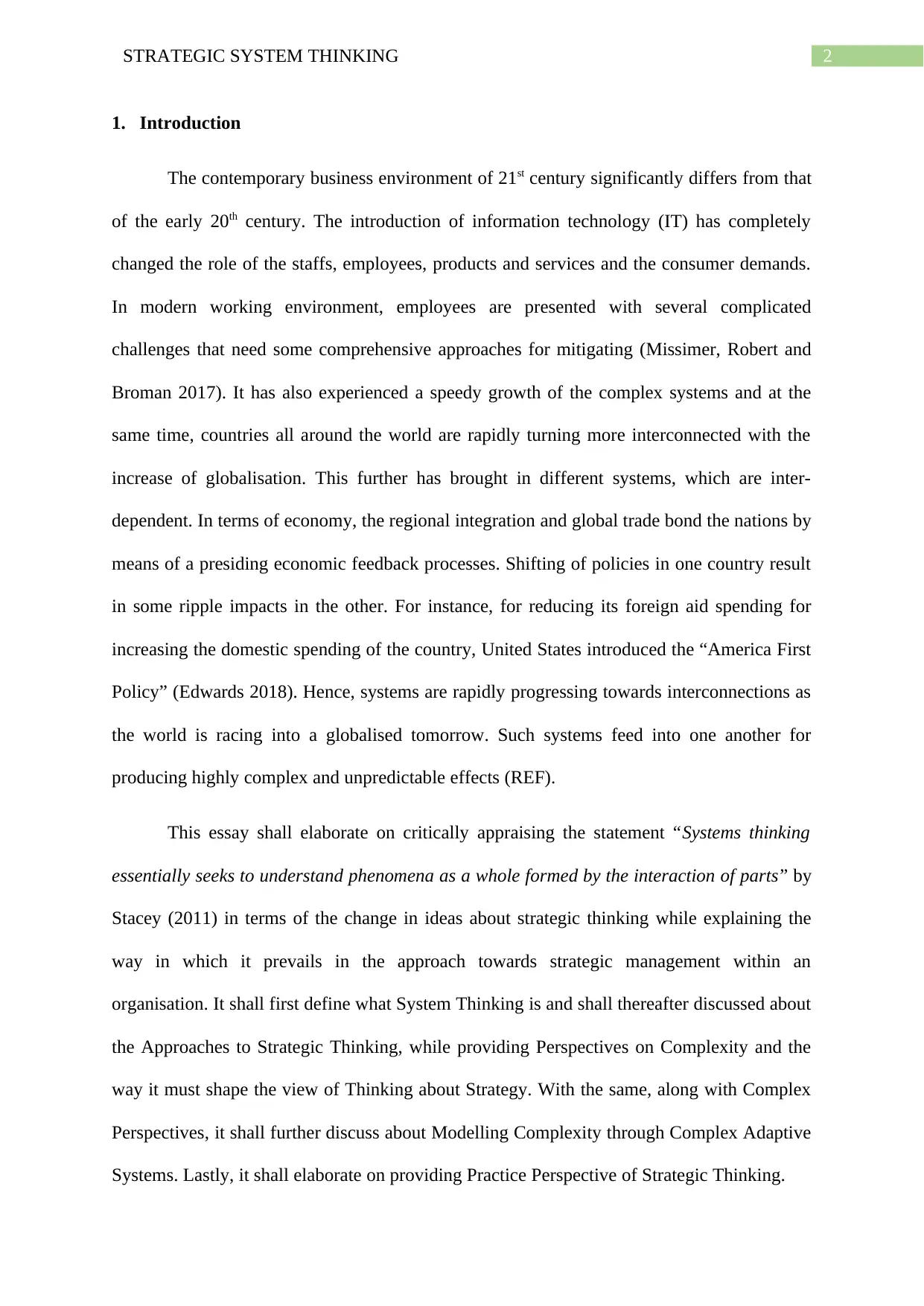
2STRATEGIC SYSTEM THINKING
1. Introduction
The contemporary business environment of 21st century significantly differs from that
of the early 20th century. The introduction of information technology (IT) has completely
changed the role of the staffs, employees, products and services and the consumer demands.
In modern working environment, employees are presented with several complicated
challenges that need some comprehensive approaches for mitigating (Missimer, Robert and
Broman 2017). It has also experienced a speedy growth of the complex systems and at the
same time, countries all around the world are rapidly turning more interconnected with the
increase of globalisation. This further has brought in different systems, which are inter-
dependent. In terms of economy, the regional integration and global trade bond the nations by
means of a presiding economic feedback processes. Shifting of policies in one country result
in some ripple impacts in the other. For instance, for reducing its foreign aid spending for
increasing the domestic spending of the country, United States introduced the “America First
Policy” (Edwards 2018). Hence, systems are rapidly progressing towards interconnections as
the world is racing into a globalised tomorrow. Such systems feed into one another for
producing highly complex and unpredictable effects (REF).
This essay shall elaborate on critically appraising the statement “Systems thinking
essentially seeks to understand phenomena as a whole formed by the interaction of parts” by
Stacey (2011) in terms of the change in ideas about strategic thinking while explaining the
way in which it prevails in the approach towards strategic management within an
organisation. It shall first define what System Thinking is and shall thereafter discussed about
the Approaches to Strategic Thinking, while providing Perspectives on Complexity and the
way it must shape the view of Thinking about Strategy. With the same, along with Complex
Perspectives, it shall further discuss about Modelling Complexity through Complex Adaptive
Systems. Lastly, it shall elaborate on providing Practice Perspective of Strategic Thinking.
1. Introduction
The contemporary business environment of 21st century significantly differs from that
of the early 20th century. The introduction of information technology (IT) has completely
changed the role of the staffs, employees, products and services and the consumer demands.
In modern working environment, employees are presented with several complicated
challenges that need some comprehensive approaches for mitigating (Missimer, Robert and
Broman 2017). It has also experienced a speedy growth of the complex systems and at the
same time, countries all around the world are rapidly turning more interconnected with the
increase of globalisation. This further has brought in different systems, which are inter-
dependent. In terms of economy, the regional integration and global trade bond the nations by
means of a presiding economic feedback processes. Shifting of policies in one country result
in some ripple impacts in the other. For instance, for reducing its foreign aid spending for
increasing the domestic spending of the country, United States introduced the “America First
Policy” (Edwards 2018). Hence, systems are rapidly progressing towards interconnections as
the world is racing into a globalised tomorrow. Such systems feed into one another for
producing highly complex and unpredictable effects (REF).
This essay shall elaborate on critically appraising the statement “Systems thinking
essentially seeks to understand phenomena as a whole formed by the interaction of parts” by
Stacey (2011) in terms of the change in ideas about strategic thinking while explaining the
way in which it prevails in the approach towards strategic management within an
organisation. It shall first define what System Thinking is and shall thereafter discussed about
the Approaches to Strategic Thinking, while providing Perspectives on Complexity and the
way it must shape the view of Thinking about Strategy. With the same, along with Complex
Perspectives, it shall further discuss about Modelling Complexity through Complex Adaptive
Systems. Lastly, it shall elaborate on providing Practice Perspective of Strategic Thinking.
⊘ This is a preview!⊘
Do you want full access?
Subscribe today to unlock all pages.

Trusted by 1+ million students worldwide
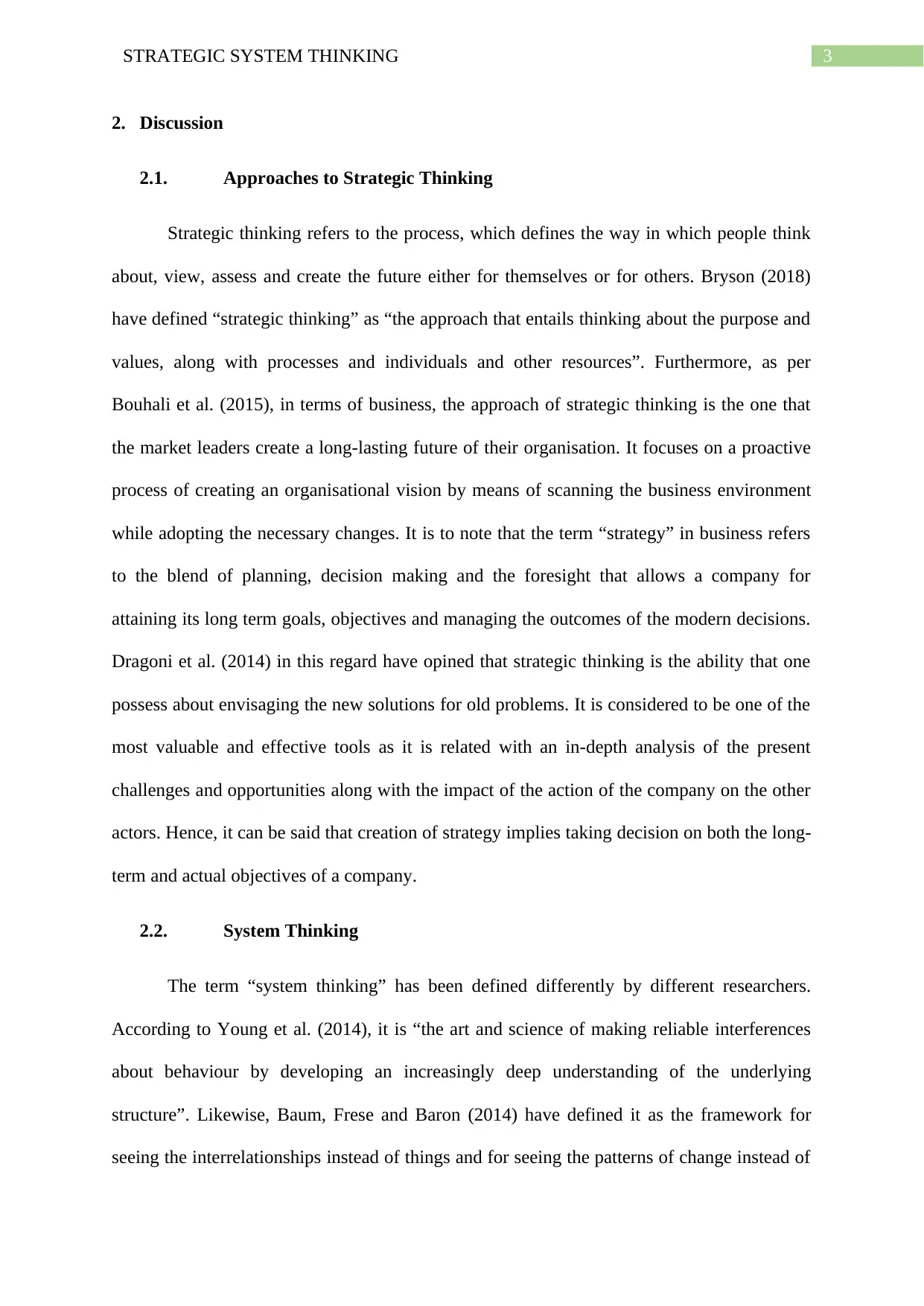
3STRATEGIC SYSTEM THINKING
2. Discussion
2.1. Approaches to Strategic Thinking
Strategic thinking refers to the process, which defines the way in which people think
about, view, assess and create the future either for themselves or for others. Bryson (2018)
have defined “strategic thinking” as “the approach that entails thinking about the purpose and
values, along with processes and individuals and other resources”. Furthermore, as per
Bouhali et al. (2015), in terms of business, the approach of strategic thinking is the one that
the market leaders create a long-lasting future of their organisation. It focuses on a proactive
process of creating an organisational vision by means of scanning the business environment
while adopting the necessary changes. It is to note that the term “strategy” in business refers
to the blend of planning, decision making and the foresight that allows a company for
attaining its long term goals, objectives and managing the outcomes of the modern decisions.
Dragoni et al. (2014) in this regard have opined that strategic thinking is the ability that one
possess about envisaging the new solutions for old problems. It is considered to be one of the
most valuable and effective tools as it is related with an in-depth analysis of the present
challenges and opportunities along with the impact of the action of the company on the other
actors. Hence, it can be said that creation of strategy implies taking decision on both the long-
term and actual objectives of a company.
2.2. System Thinking
The term “system thinking” has been defined differently by different researchers.
According to Young et al. (2014), it is “the art and science of making reliable interferences
about behaviour by developing an increasingly deep understanding of the underlying
structure”. Likewise, Baum, Frese and Baron (2014) have defined it as the framework for
seeing the interrelationships instead of things and for seeing the patterns of change instead of
2. Discussion
2.1. Approaches to Strategic Thinking
Strategic thinking refers to the process, which defines the way in which people think
about, view, assess and create the future either for themselves or for others. Bryson (2018)
have defined “strategic thinking” as “the approach that entails thinking about the purpose and
values, along with processes and individuals and other resources”. Furthermore, as per
Bouhali et al. (2015), in terms of business, the approach of strategic thinking is the one that
the market leaders create a long-lasting future of their organisation. It focuses on a proactive
process of creating an organisational vision by means of scanning the business environment
while adopting the necessary changes. It is to note that the term “strategy” in business refers
to the blend of planning, decision making and the foresight that allows a company for
attaining its long term goals, objectives and managing the outcomes of the modern decisions.
Dragoni et al. (2014) in this regard have opined that strategic thinking is the ability that one
possess about envisaging the new solutions for old problems. It is considered to be one of the
most valuable and effective tools as it is related with an in-depth analysis of the present
challenges and opportunities along with the impact of the action of the company on the other
actors. Hence, it can be said that creation of strategy implies taking decision on both the long-
term and actual objectives of a company.
2.2. System Thinking
The term “system thinking” has been defined differently by different researchers.
According to Young et al. (2014), it is “the art and science of making reliable interferences
about behaviour by developing an increasingly deep understanding of the underlying
structure”. Likewise, Baum, Frese and Baron (2014) have defined it as the framework for
seeing the interrelationships instead of things and for seeing the patterns of change instead of
Paraphrase This Document
Need a fresh take? Get an instant paraphrase of this document with our AI Paraphraser
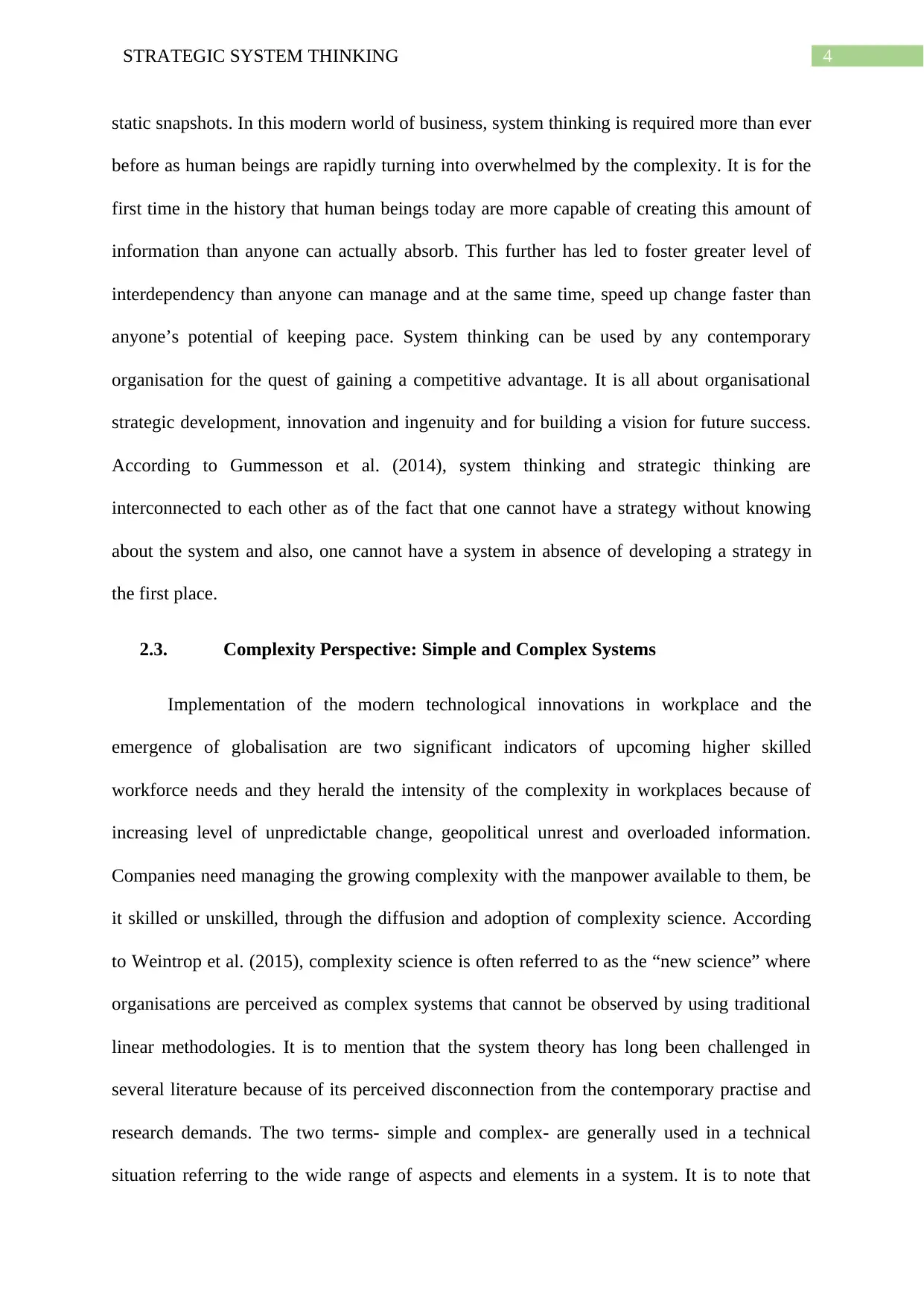
4STRATEGIC SYSTEM THINKING
static snapshots. In this modern world of business, system thinking is required more than ever
before as human beings are rapidly turning into overwhelmed by the complexity. It is for the
first time in the history that human beings today are more capable of creating this amount of
information than anyone can actually absorb. This further has led to foster greater level of
interdependency than anyone can manage and at the same time, speed up change faster than
anyone’s potential of keeping pace. System thinking can be used by any contemporary
organisation for the quest of gaining a competitive advantage. It is all about organisational
strategic development, innovation and ingenuity and for building a vision for future success.
According to Gummesson et al. (2014), system thinking and strategic thinking are
interconnected to each other as of the fact that one cannot have a strategy without knowing
about the system and also, one cannot have a system in absence of developing a strategy in
the first place.
2.3. Complexity Perspective: Simple and Complex Systems
Implementation of the modern technological innovations in workplace and the
emergence of globalisation are two significant indicators of upcoming higher skilled
workforce needs and they herald the intensity of the complexity in workplaces because of
increasing level of unpredictable change, geopolitical unrest and overloaded information.
Companies need managing the growing complexity with the manpower available to them, be
it skilled or unskilled, through the diffusion and adoption of complexity science. According
to Weintrop et al. (2015), complexity science is often referred to as the “new science” where
organisations are perceived as complex systems that cannot be observed by using traditional
linear methodologies. It is to mention that the system theory has long been challenged in
several literature because of its perceived disconnection from the contemporary practise and
research demands. The two terms- simple and complex- are generally used in a technical
situation referring to the wide range of aspects and elements in a system. It is to note that
static snapshots. In this modern world of business, system thinking is required more than ever
before as human beings are rapidly turning into overwhelmed by the complexity. It is for the
first time in the history that human beings today are more capable of creating this amount of
information than anyone can actually absorb. This further has led to foster greater level of
interdependency than anyone can manage and at the same time, speed up change faster than
anyone’s potential of keeping pace. System thinking can be used by any contemporary
organisation for the quest of gaining a competitive advantage. It is all about organisational
strategic development, innovation and ingenuity and for building a vision for future success.
According to Gummesson et al. (2014), system thinking and strategic thinking are
interconnected to each other as of the fact that one cannot have a strategy without knowing
about the system and also, one cannot have a system in absence of developing a strategy in
the first place.
2.3. Complexity Perspective: Simple and Complex Systems
Implementation of the modern technological innovations in workplace and the
emergence of globalisation are two significant indicators of upcoming higher skilled
workforce needs and they herald the intensity of the complexity in workplaces because of
increasing level of unpredictable change, geopolitical unrest and overloaded information.
Companies need managing the growing complexity with the manpower available to them, be
it skilled or unskilled, through the diffusion and adoption of complexity science. According
to Weintrop et al. (2015), complexity science is often referred to as the “new science” where
organisations are perceived as complex systems that cannot be observed by using traditional
linear methodologies. It is to mention that the system theory has long been challenged in
several literature because of its perceived disconnection from the contemporary practise and
research demands. The two terms- simple and complex- are generally used in a technical
situation referring to the wide range of aspects and elements in a system. It is to note that
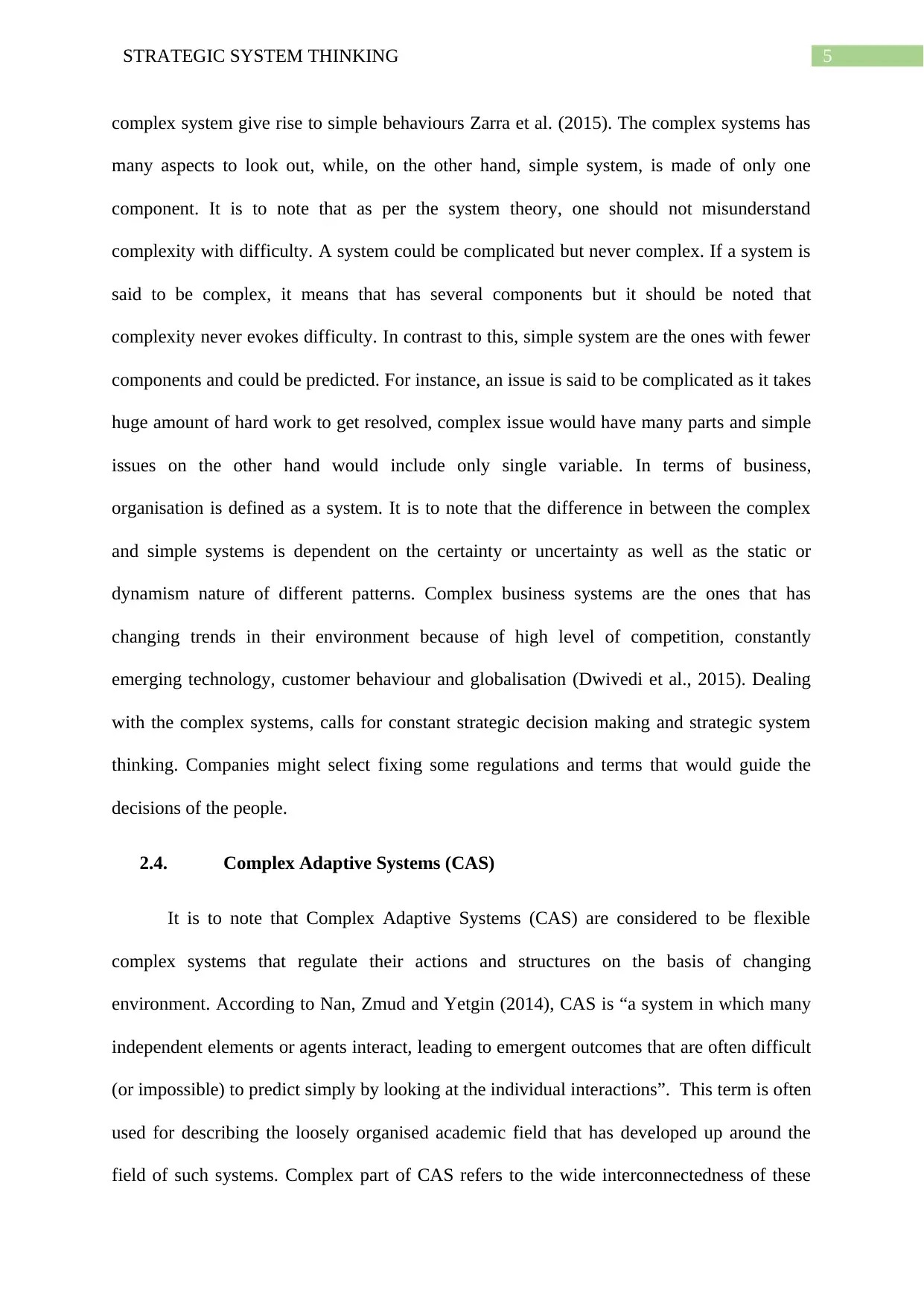
5STRATEGIC SYSTEM THINKING
complex system give rise to simple behaviours Zarra et al. (2015). The complex systems has
many aspects to look out, while, on the other hand, simple system, is made of only one
component. It is to note that as per the system theory, one should not misunderstand
complexity with difficulty. A system could be complicated but never complex. If a system is
said to be complex, it means that has several components but it should be noted that
complexity never evokes difficulty. In contrast to this, simple system are the ones with fewer
components and could be predicted. For instance, an issue is said to be complicated as it takes
huge amount of hard work to get resolved, complex issue would have many parts and simple
issues on the other hand would include only single variable. In terms of business,
organisation is defined as a system. It is to note that the difference in between the complex
and simple systems is dependent on the certainty or uncertainty as well as the static or
dynamism nature of different patterns. Complex business systems are the ones that has
changing trends in their environment because of high level of competition, constantly
emerging technology, customer behaviour and globalisation (Dwivedi et al., 2015). Dealing
with the complex systems, calls for constant strategic decision making and strategic system
thinking. Companies might select fixing some regulations and terms that would guide the
decisions of the people.
2.4. Complex Adaptive Systems (CAS)
It is to note that Complex Adaptive Systems (CAS) are considered to be flexible
complex systems that regulate their actions and structures on the basis of changing
environment. According to Nan, Zmud and Yetgin (2014), CAS is “a system in which many
independent elements or agents interact, leading to emergent outcomes that are often difficult
(or impossible) to predict simply by looking at the individual interactions”. This term is often
used for describing the loosely organised academic field that has developed up around the
field of such systems. Complex part of CAS refers to the wide interconnectedness of these
complex system give rise to simple behaviours Zarra et al. (2015). The complex systems has
many aspects to look out, while, on the other hand, simple system, is made of only one
component. It is to note that as per the system theory, one should not misunderstand
complexity with difficulty. A system could be complicated but never complex. If a system is
said to be complex, it means that has several components but it should be noted that
complexity never evokes difficulty. In contrast to this, simple system are the ones with fewer
components and could be predicted. For instance, an issue is said to be complicated as it takes
huge amount of hard work to get resolved, complex issue would have many parts and simple
issues on the other hand would include only single variable. In terms of business,
organisation is defined as a system. It is to note that the difference in between the complex
and simple systems is dependent on the certainty or uncertainty as well as the static or
dynamism nature of different patterns. Complex business systems are the ones that has
changing trends in their environment because of high level of competition, constantly
emerging technology, customer behaviour and globalisation (Dwivedi et al., 2015). Dealing
with the complex systems, calls for constant strategic decision making and strategic system
thinking. Companies might select fixing some regulations and terms that would guide the
decisions of the people.
2.4. Complex Adaptive Systems (CAS)
It is to note that Complex Adaptive Systems (CAS) are considered to be flexible
complex systems that regulate their actions and structures on the basis of changing
environment. According to Nan, Zmud and Yetgin (2014), CAS is “a system in which many
independent elements or agents interact, leading to emergent outcomes that are often difficult
(or impossible) to predict simply by looking at the individual interactions”. This term is often
used for describing the loosely organised academic field that has developed up around the
field of such systems. Complex part of CAS refers to the wide interconnectedness of these
⊘ This is a preview!⊘
Do you want full access?
Subscribe today to unlock all pages.

Trusted by 1+ million students worldwide
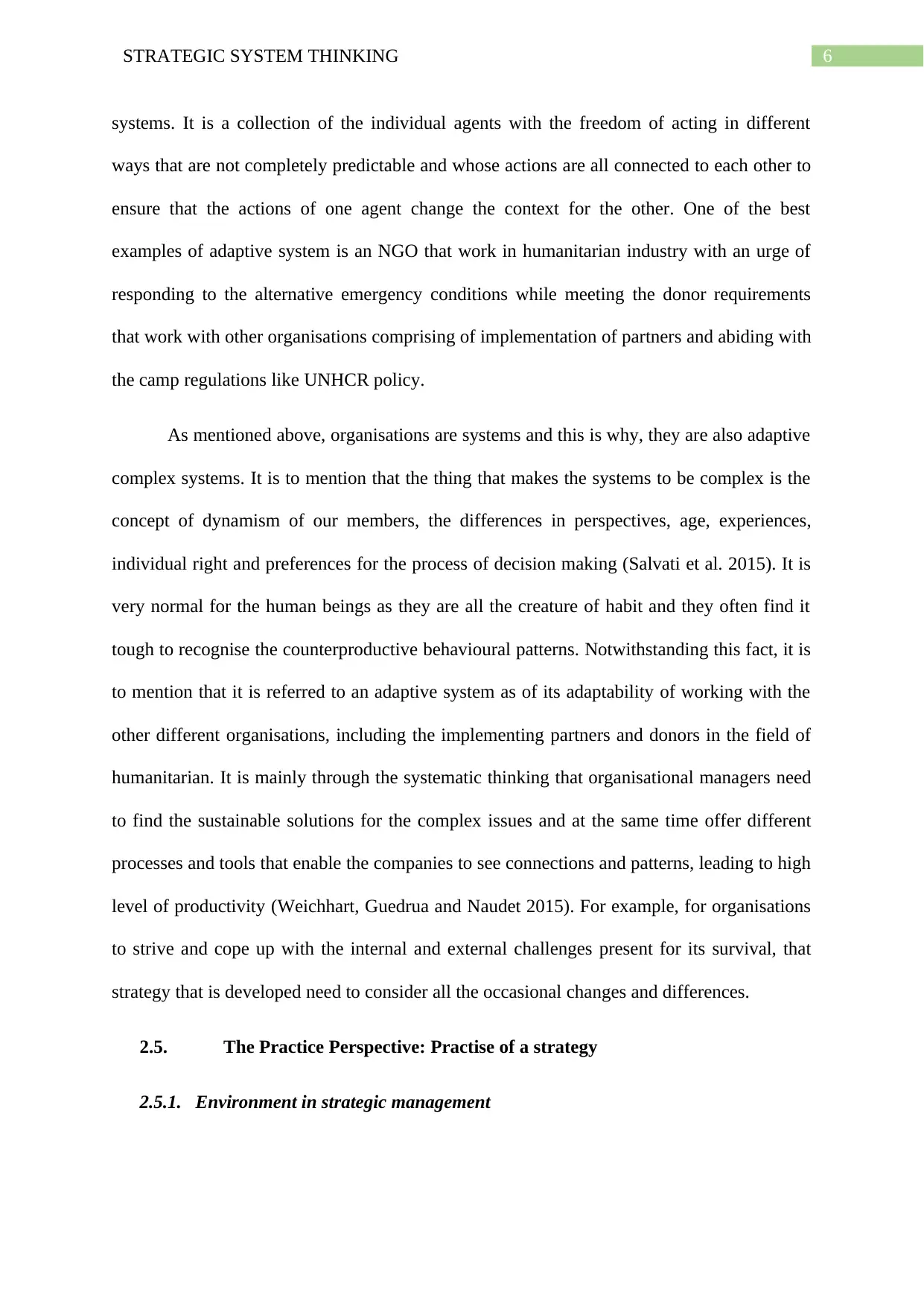
6STRATEGIC SYSTEM THINKING
systems. It is a collection of the individual agents with the freedom of acting in different
ways that are not completely predictable and whose actions are all connected to each other to
ensure that the actions of one agent change the context for the other. One of the best
examples of adaptive system is an NGO that work in humanitarian industry with an urge of
responding to the alternative emergency conditions while meeting the donor requirements
that work with other organisations comprising of implementation of partners and abiding with
the camp regulations like UNHCR policy.
As mentioned above, organisations are systems and this is why, they are also adaptive
complex systems. It is to mention that the thing that makes the systems to be complex is the
concept of dynamism of our members, the differences in perspectives, age, experiences,
individual right and preferences for the process of decision making (Salvati et al. 2015). It is
very normal for the human beings as they are all the creature of habit and they often find it
tough to recognise the counterproductive behavioural patterns. Notwithstanding this fact, it is
to mention that it is referred to an adaptive system as of its adaptability of working with the
other different organisations, including the implementing partners and donors in the field of
humanitarian. It is mainly through the systematic thinking that organisational managers need
to find the sustainable solutions for the complex issues and at the same time offer different
processes and tools that enable the companies to see connections and patterns, leading to high
level of productivity (Weichhart, Guedrua and Naudet 2015). For example, for organisations
to strive and cope up with the internal and external challenges present for its survival, that
strategy that is developed need to consider all the occasional changes and differences.
2.5. The Practice Perspective: Practise of a strategy
2.5.1. Environment in strategic management
systems. It is a collection of the individual agents with the freedom of acting in different
ways that are not completely predictable and whose actions are all connected to each other to
ensure that the actions of one agent change the context for the other. One of the best
examples of adaptive system is an NGO that work in humanitarian industry with an urge of
responding to the alternative emergency conditions while meeting the donor requirements
that work with other organisations comprising of implementation of partners and abiding with
the camp regulations like UNHCR policy.
As mentioned above, organisations are systems and this is why, they are also adaptive
complex systems. It is to mention that the thing that makes the systems to be complex is the
concept of dynamism of our members, the differences in perspectives, age, experiences,
individual right and preferences for the process of decision making (Salvati et al. 2015). It is
very normal for the human beings as they are all the creature of habit and they often find it
tough to recognise the counterproductive behavioural patterns. Notwithstanding this fact, it is
to mention that it is referred to an adaptive system as of its adaptability of working with the
other different organisations, including the implementing partners and donors in the field of
humanitarian. It is mainly through the systematic thinking that organisational managers need
to find the sustainable solutions for the complex issues and at the same time offer different
processes and tools that enable the companies to see connections and patterns, leading to high
level of productivity (Weichhart, Guedrua and Naudet 2015). For example, for organisations
to strive and cope up with the internal and external challenges present for its survival, that
strategy that is developed need to consider all the occasional changes and differences.
2.5. The Practice Perspective: Practise of a strategy
2.5.1. Environment in strategic management
Paraphrase This Document
Need a fresh take? Get an instant paraphrase of this document with our AI Paraphraser
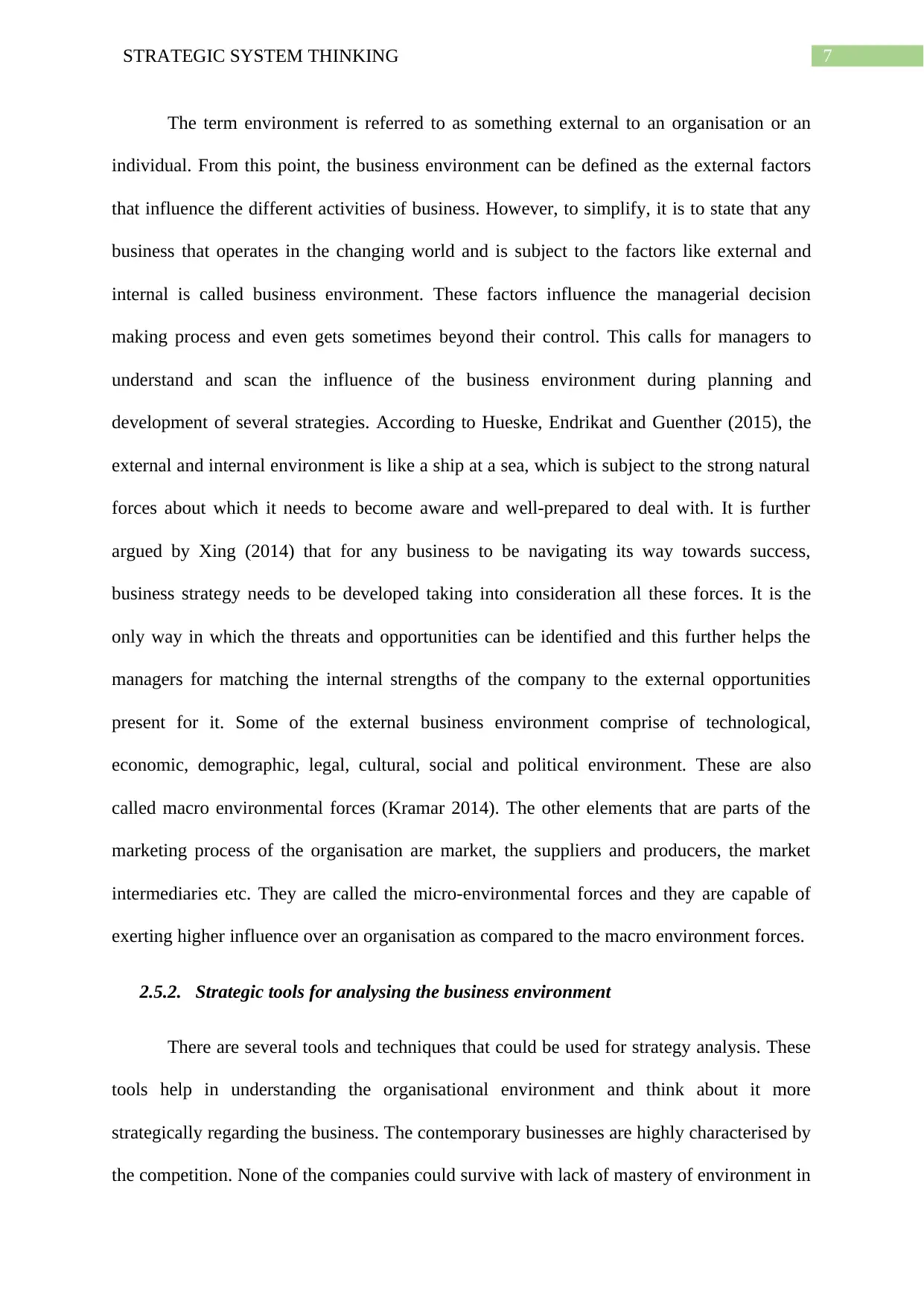
7STRATEGIC SYSTEM THINKING
The term environment is referred to as something external to an organisation or an
individual. From this point, the business environment can be defined as the external factors
that influence the different activities of business. However, to simplify, it is to state that any
business that operates in the changing world and is subject to the factors like external and
internal is called business environment. These factors influence the managerial decision
making process and even gets sometimes beyond their control. This calls for managers to
understand and scan the influence of the business environment during planning and
development of several strategies. According to Hueske, Endrikat and Guenther (2015), the
external and internal environment is like a ship at a sea, which is subject to the strong natural
forces about which it needs to become aware and well-prepared to deal with. It is further
argued by Xing (2014) that for any business to be navigating its way towards success,
business strategy needs to be developed taking into consideration all these forces. It is the
only way in which the threats and opportunities can be identified and this further helps the
managers for matching the internal strengths of the company to the external opportunities
present for it. Some of the external business environment comprise of technological,
economic, demographic, legal, cultural, social and political environment. These are also
called macro environmental forces (Kramar 2014). The other elements that are parts of the
marketing process of the organisation are market, the suppliers and producers, the market
intermediaries etc. They are called the micro-environmental forces and they are capable of
exerting higher influence over an organisation as compared to the macro environment forces.
2.5.2. Strategic tools for analysing the business environment
There are several tools and techniques that could be used for strategy analysis. These
tools help in understanding the organisational environment and think about it more
strategically regarding the business. The contemporary businesses are highly characterised by
the competition. None of the companies could survive with lack of mastery of environment in
The term environment is referred to as something external to an organisation or an
individual. From this point, the business environment can be defined as the external factors
that influence the different activities of business. However, to simplify, it is to state that any
business that operates in the changing world and is subject to the factors like external and
internal is called business environment. These factors influence the managerial decision
making process and even gets sometimes beyond their control. This calls for managers to
understand and scan the influence of the business environment during planning and
development of several strategies. According to Hueske, Endrikat and Guenther (2015), the
external and internal environment is like a ship at a sea, which is subject to the strong natural
forces about which it needs to become aware and well-prepared to deal with. It is further
argued by Xing (2014) that for any business to be navigating its way towards success,
business strategy needs to be developed taking into consideration all these forces. It is the
only way in which the threats and opportunities can be identified and this further helps the
managers for matching the internal strengths of the company to the external opportunities
present for it. Some of the external business environment comprise of technological,
economic, demographic, legal, cultural, social and political environment. These are also
called macro environmental forces (Kramar 2014). The other elements that are parts of the
marketing process of the organisation are market, the suppliers and producers, the market
intermediaries etc. They are called the micro-environmental forces and they are capable of
exerting higher influence over an organisation as compared to the macro environment forces.
2.5.2. Strategic tools for analysing the business environment
There are several tools and techniques that could be used for strategy analysis. These
tools help in understanding the organisational environment and think about it more
strategically regarding the business. The contemporary businesses are highly characterised by
the competition. None of the companies could survive with lack of mastery of environment in
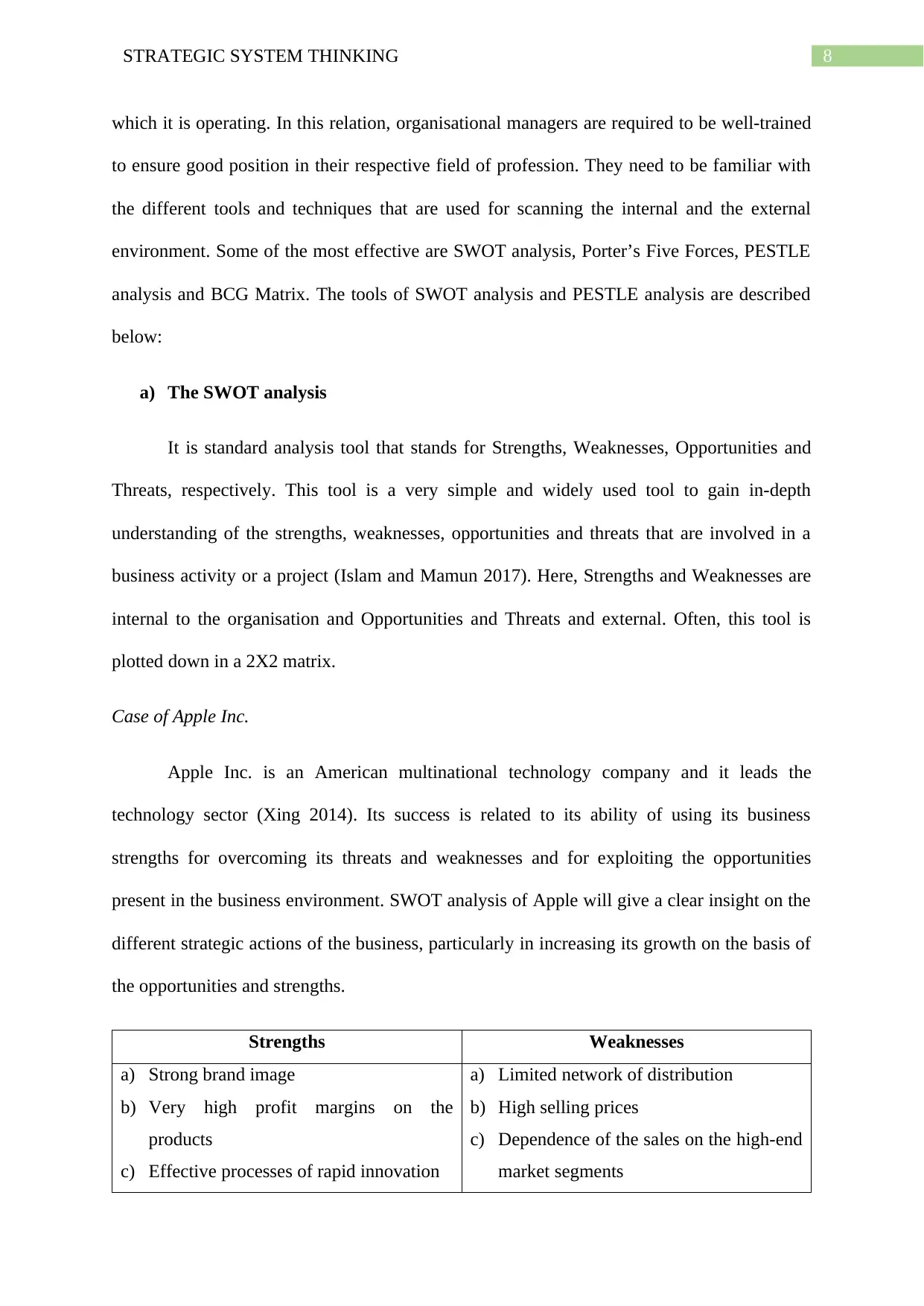
8STRATEGIC SYSTEM THINKING
which it is operating. In this relation, organisational managers are required to be well-trained
to ensure good position in their respective field of profession. They need to be familiar with
the different tools and techniques that are used for scanning the internal and the external
environment. Some of the most effective are SWOT analysis, Porter’s Five Forces, PESTLE
analysis and BCG Matrix. The tools of SWOT analysis and PESTLE analysis are described
below:
a) The SWOT analysis
It is standard analysis tool that stands for Strengths, Weaknesses, Opportunities and
Threats, respectively. This tool is a very simple and widely used tool to gain in-depth
understanding of the strengths, weaknesses, opportunities and threats that are involved in a
business activity or a project (Islam and Mamun 2017). Here, Strengths and Weaknesses are
internal to the organisation and Opportunities and Threats and external. Often, this tool is
plotted down in a 2X2 matrix.
Case of Apple Inc.
Apple Inc. is an American multinational technology company and it leads the
technology sector (Xing 2014). Its success is related to its ability of using its business
strengths for overcoming its threats and weaknesses and for exploiting the opportunities
present in the business environment. SWOT analysis of Apple will give a clear insight on the
different strategic actions of the business, particularly in increasing its growth on the basis of
the opportunities and strengths.
Strengths Weaknesses
a) Strong brand image
b) Very high profit margins on the
products
c) Effective processes of rapid innovation
a) Limited network of distribution
b) High selling prices
c) Dependence of the sales on the high-end
market segments
which it is operating. In this relation, organisational managers are required to be well-trained
to ensure good position in their respective field of profession. They need to be familiar with
the different tools and techniques that are used for scanning the internal and the external
environment. Some of the most effective are SWOT analysis, Porter’s Five Forces, PESTLE
analysis and BCG Matrix. The tools of SWOT analysis and PESTLE analysis are described
below:
a) The SWOT analysis
It is standard analysis tool that stands for Strengths, Weaknesses, Opportunities and
Threats, respectively. This tool is a very simple and widely used tool to gain in-depth
understanding of the strengths, weaknesses, opportunities and threats that are involved in a
business activity or a project (Islam and Mamun 2017). Here, Strengths and Weaknesses are
internal to the organisation and Opportunities and Threats and external. Often, this tool is
plotted down in a 2X2 matrix.
Case of Apple Inc.
Apple Inc. is an American multinational technology company and it leads the
technology sector (Xing 2014). Its success is related to its ability of using its business
strengths for overcoming its threats and weaknesses and for exploiting the opportunities
present in the business environment. SWOT analysis of Apple will give a clear insight on the
different strategic actions of the business, particularly in increasing its growth on the basis of
the opportunities and strengths.
Strengths Weaknesses
a) Strong brand image
b) Very high profit margins on the
products
c) Effective processes of rapid innovation
a) Limited network of distribution
b) High selling prices
c) Dependence of the sales on the high-end
market segments
⊘ This is a preview!⊘
Do you want full access?
Subscribe today to unlock all pages.

Trusted by 1+ million students worldwide
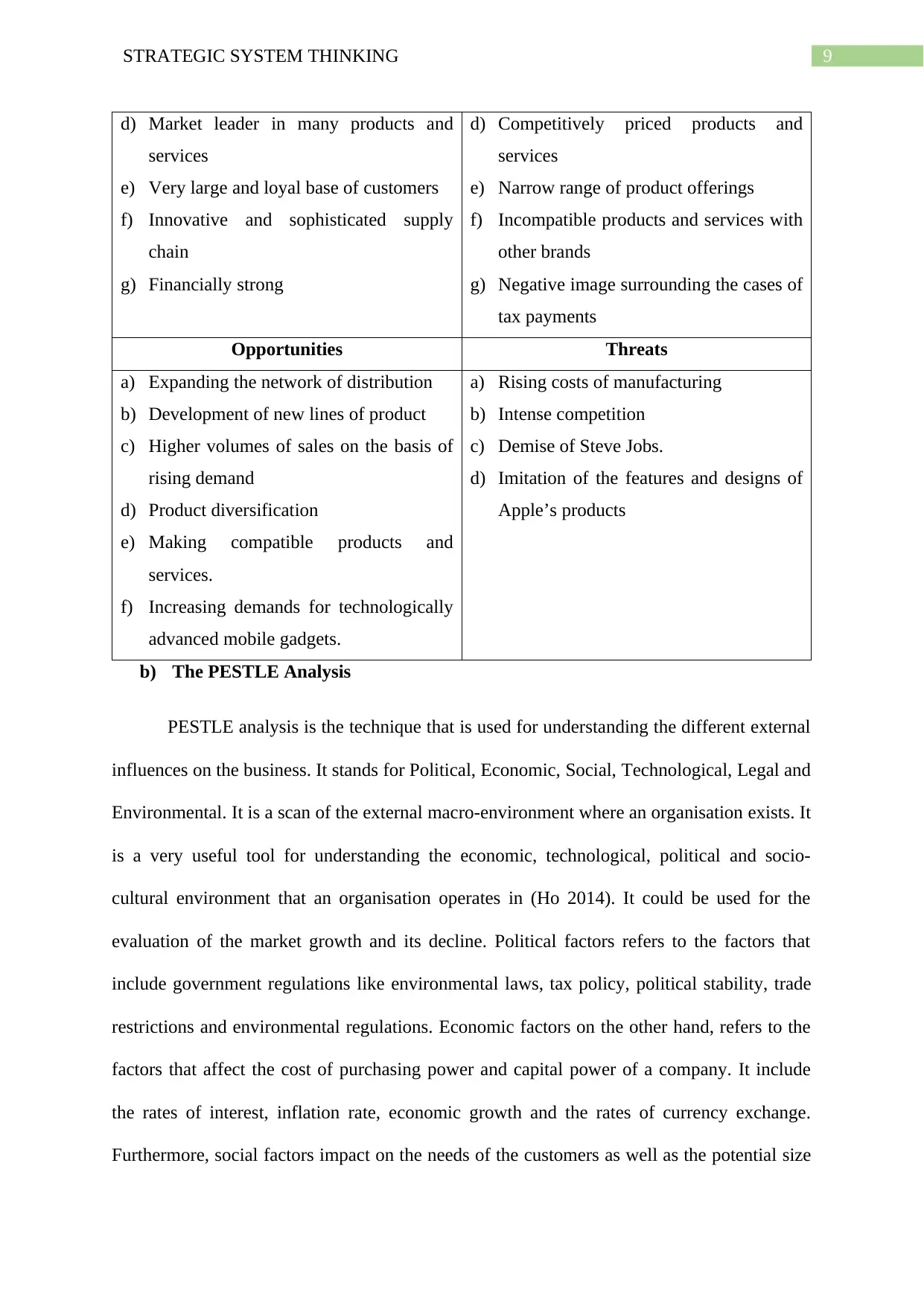
9STRATEGIC SYSTEM THINKING
d) Market leader in many products and
services
e) Very large and loyal base of customers
f) Innovative and sophisticated supply
chain
g) Financially strong
d) Competitively priced products and
services
e) Narrow range of product offerings
f) Incompatible products and services with
other brands
g) Negative image surrounding the cases of
tax payments
Opportunities Threats
a) Expanding the network of distribution
b) Development of new lines of product
c) Higher volumes of sales on the basis of
rising demand
d) Product diversification
e) Making compatible products and
services.
f) Increasing demands for technologically
advanced mobile gadgets.
a) Rising costs of manufacturing
b) Intense competition
c) Demise of Steve Jobs.
d) Imitation of the features and designs of
Apple’s products
b) The PESTLE Analysis
PESTLE analysis is the technique that is used for understanding the different external
influences on the business. It stands for Political, Economic, Social, Technological, Legal and
Environmental. It is a scan of the external macro-environment where an organisation exists. It
is a very useful tool for understanding the economic, technological, political and socio-
cultural environment that an organisation operates in (Ho 2014). It could be used for the
evaluation of the market growth and its decline. Political factors refers to the factors that
include government regulations like environmental laws, tax policy, political stability, trade
restrictions and environmental regulations. Economic factors on the other hand, refers to the
factors that affect the cost of purchasing power and capital power of a company. It include
the rates of interest, inflation rate, economic growth and the rates of currency exchange.
Furthermore, social factors impact on the needs of the customers as well as the potential size
d) Market leader in many products and
services
e) Very large and loyal base of customers
f) Innovative and sophisticated supply
chain
g) Financially strong
d) Competitively priced products and
services
e) Narrow range of product offerings
f) Incompatible products and services with
other brands
g) Negative image surrounding the cases of
tax payments
Opportunities Threats
a) Expanding the network of distribution
b) Development of new lines of product
c) Higher volumes of sales on the basis of
rising demand
d) Product diversification
e) Making compatible products and
services.
f) Increasing demands for technologically
advanced mobile gadgets.
a) Rising costs of manufacturing
b) Intense competition
c) Demise of Steve Jobs.
d) Imitation of the features and designs of
Apple’s products
b) The PESTLE Analysis
PESTLE analysis is the technique that is used for understanding the different external
influences on the business. It stands for Political, Economic, Social, Technological, Legal and
Environmental. It is a scan of the external macro-environment where an organisation exists. It
is a very useful tool for understanding the economic, technological, political and socio-
cultural environment that an organisation operates in (Ho 2014). It could be used for the
evaluation of the market growth and its decline. Political factors refers to the factors that
include government regulations like environmental laws, tax policy, political stability, trade
restrictions and environmental regulations. Economic factors on the other hand, refers to the
factors that affect the cost of purchasing power and capital power of a company. It include
the rates of interest, inflation rate, economic growth and the rates of currency exchange.
Furthermore, social factors impact on the needs of the customers as well as the potential size
Paraphrase This Document
Need a fresh take? Get an instant paraphrase of this document with our AI Paraphraser
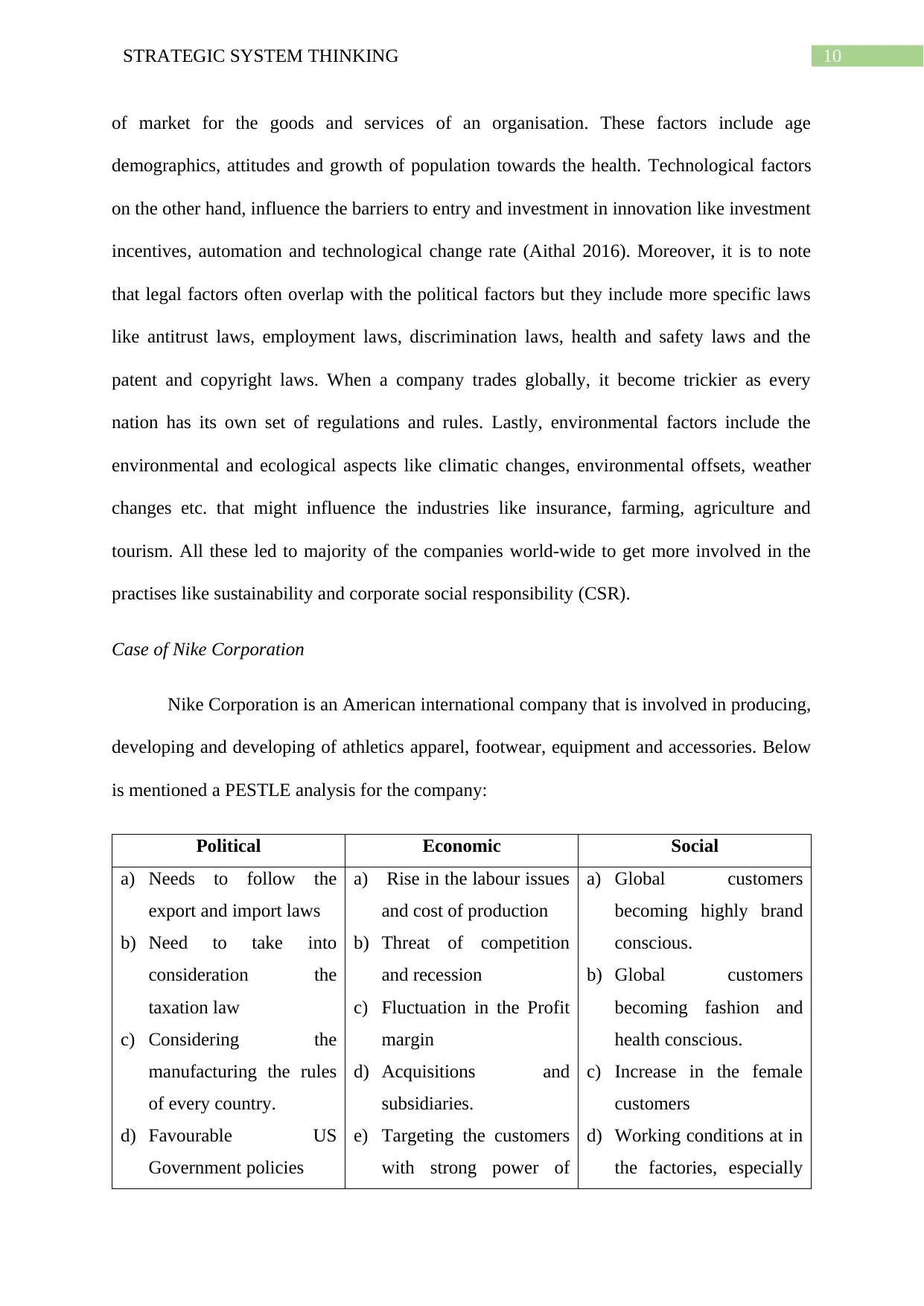
10STRATEGIC SYSTEM THINKING
of market for the goods and services of an organisation. These factors include age
demographics, attitudes and growth of population towards the health. Technological factors
on the other hand, influence the barriers to entry and investment in innovation like investment
incentives, automation and technological change rate (Aithal 2016). Moreover, it is to note
that legal factors often overlap with the political factors but they include more specific laws
like antitrust laws, employment laws, discrimination laws, health and safety laws and the
patent and copyright laws. When a company trades globally, it become trickier as every
nation has its own set of regulations and rules. Lastly, environmental factors include the
environmental and ecological aspects like climatic changes, environmental offsets, weather
changes etc. that might influence the industries like insurance, farming, agriculture and
tourism. All these led to majority of the companies world-wide to get more involved in the
practises like sustainability and corporate social responsibility (CSR).
Case of Nike Corporation
Nike Corporation is an American international company that is involved in producing,
developing and developing of athletics apparel, footwear, equipment and accessories. Below
is mentioned a PESTLE analysis for the company:
Political Economic Social
a) Needs to follow the
export and import laws
b) Need to take into
consideration the
taxation law
c) Considering the
manufacturing the rules
of every country.
d) Favourable US
Government policies
a) Rise in the labour issues
and cost of production
b) Threat of competition
and recession
c) Fluctuation in the Profit
margin
d) Acquisitions and
subsidiaries.
e) Targeting the customers
with strong power of
a) Global customers
becoming highly brand
conscious.
b) Global customers
becoming fashion and
health conscious.
c) Increase in the female
customers
d) Working conditions at in
the factories, especially
of market for the goods and services of an organisation. These factors include age
demographics, attitudes and growth of population towards the health. Technological factors
on the other hand, influence the barriers to entry and investment in innovation like investment
incentives, automation and technological change rate (Aithal 2016). Moreover, it is to note
that legal factors often overlap with the political factors but they include more specific laws
like antitrust laws, employment laws, discrimination laws, health and safety laws and the
patent and copyright laws. When a company trades globally, it become trickier as every
nation has its own set of regulations and rules. Lastly, environmental factors include the
environmental and ecological aspects like climatic changes, environmental offsets, weather
changes etc. that might influence the industries like insurance, farming, agriculture and
tourism. All these led to majority of the companies world-wide to get more involved in the
practises like sustainability and corporate social responsibility (CSR).
Case of Nike Corporation
Nike Corporation is an American international company that is involved in producing,
developing and developing of athletics apparel, footwear, equipment and accessories. Below
is mentioned a PESTLE analysis for the company:
Political Economic Social
a) Needs to follow the
export and import laws
b) Need to take into
consideration the
taxation law
c) Considering the
manufacturing the rules
of every country.
d) Favourable US
Government policies
a) Rise in the labour issues
and cost of production
b) Threat of competition
and recession
c) Fluctuation in the Profit
margin
d) Acquisitions and
subsidiaries.
e) Targeting the customers
with strong power of
a) Global customers
becoming highly brand
conscious.
b) Global customers
becoming fashion and
health conscious.
c) Increase in the female
customers
d) Working conditions at in
the factories, especially

11STRATEGIC SYSTEM THINKING
e) Change in the
International law
f) Political unrest several
Asian nations
purchasing. in the Asian countries.
Technological Legal Environmental
a) Innovation in the
products and services.
b) Different marketing
techniques and strategies
for reaching customers
and the prospective
consumers.
a) Legal battles with
Adidas and the other
market competitors.
b) Minimum wage
allegations.
c) Counterfeit products that
affect the annual revenue
of the company
drastically.
d) Paradise Papers
a) Environmental concern
like global warming to
reduce waste.
b) Pollution concern in
China
c) Decreasing the emission
of greenhouse gases
throughout the value
chain.
3. Conclusion
Hence, from the above analysis it is to conclude that strategic thinking cannot be
executed successfully without ensuring proper organisation design as effective organisational
design helps in building the strategic capability of the company. With the same, strategic
design also defines a clear success indicators that assists the company in being able of
adapting the changing market conditions without influencing the suppliers and employees in
negative manner. It showcases effective work and refining communication. Companies need
managing the growing complexity with the manpower available to them, be it skilled or
unskilled, through the diffusion and adoption of complexity science. In order to do so,
organisational managers also have a strong role to play. There are various strategic analysis
tool that they can use for effective strategic planning. It is mainly through the systematic
thinking that organisational managers need to find the sustainable solutions for the complex
issues and at the same time offer different processes and tools that enable the companies to
see connections and patterns, leading to high level of productivity. They need to scan and
e) Change in the
International law
f) Political unrest several
Asian nations
purchasing. in the Asian countries.
Technological Legal Environmental
a) Innovation in the
products and services.
b) Different marketing
techniques and strategies
for reaching customers
and the prospective
consumers.
a) Legal battles with
Adidas and the other
market competitors.
b) Minimum wage
allegations.
c) Counterfeit products that
affect the annual revenue
of the company
drastically.
d) Paradise Papers
a) Environmental concern
like global warming to
reduce waste.
b) Pollution concern in
China
c) Decreasing the emission
of greenhouse gases
throughout the value
chain.
3. Conclusion
Hence, from the above analysis it is to conclude that strategic thinking cannot be
executed successfully without ensuring proper organisation design as effective organisational
design helps in building the strategic capability of the company. With the same, strategic
design also defines a clear success indicators that assists the company in being able of
adapting the changing market conditions without influencing the suppliers and employees in
negative manner. It showcases effective work and refining communication. Companies need
managing the growing complexity with the manpower available to them, be it skilled or
unskilled, through the diffusion and adoption of complexity science. In order to do so,
organisational managers also have a strong role to play. There are various strategic analysis
tool that they can use for effective strategic planning. It is mainly through the systematic
thinking that organisational managers need to find the sustainable solutions for the complex
issues and at the same time offer different processes and tools that enable the companies to
see connections and patterns, leading to high level of productivity. They need to scan and
⊘ This is a preview!⊘
Do you want full access?
Subscribe today to unlock all pages.

Trusted by 1+ million students worldwide
1 out of 15
Related Documents
Your All-in-One AI-Powered Toolkit for Academic Success.
+13062052269
info@desklib.com
Available 24*7 on WhatsApp / Email
![[object Object]](/_next/static/media/star-bottom.7253800d.svg)
Unlock your academic potential
Copyright © 2020–2025 A2Z Services. All Rights Reserved. Developed and managed by ZUCOL.





